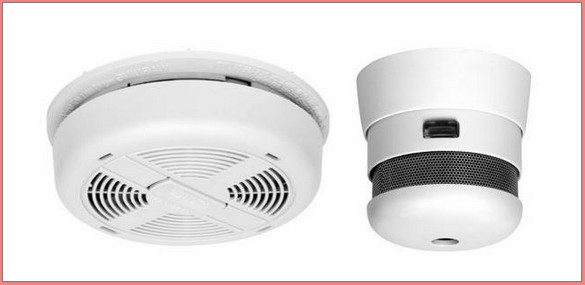There are basically two types of technologies used to develop or manufacture smoke detectors; these are ionization and photoelectric technologies. Ionization smoke detectors are made using a very minute amount of radioactive material which is placed between two charged plates. Such a configuration ionizes the surrounding air, causing some current to flow through the plates in the process. When smoke enters that particular chamber, the normal flow of ions is disrupted, the flow of current is reduced and the alarm is triggered.

Ionization smoke detectors are quite inexpensive and are known to generally work much better when a fire is flaming. They are not as effective though when the fire is just smoldering. This is mainly because ionization smoke detectors are known to pick up on very small specks of smoke, alerting you much earlier in case you have a fire which has rapid flames which usually tend to have or produce less smoke.
They are also better suited for rooms that are packed with combustibles such as flammable liquids, cleaning solutions and heaps of newspapers. This is because combustible materials usually cause flames to spread pretty fast and thus this kind of detector will work quite well in such a set up.
Just like any other product, these ionization smoke detectors do also have some cons or disadvantages. They have been found to be less effective for smoldering fires since they take too long to respond or warn homeowners or users of the premise. In most instances, they have been found to be almost ten minutes slower; this can be disastrous if lots of valuables are concerned.
Another disadvantage is their ultra sensitivity to smoke. Because of this, they tend to give very many false alarms because they can be triggered by basic home cooking activities and even bathroom steam, this affects the level of preparedness users of these detectors may have in case of a real emergency. Here are examples of ionization smoke detectors:
1) Product name: Kidde i4618 Firex Hardwire ionization Smoke detector with Battery backup
Price: $ 12.98
Web URL: http://is.gd/l6irss
Product details: has a front loading battery door which makes the process of battery changing relatively simple and a power link tab which makes the installation relatively fast. It also has a visible low battery indicator which helps in the location of the chirping unit.
2) Product name: Kidde KN- COSM- B- ionization Smoke and Carbon Monoxide Alarm
Price: $ 31.84
Web URL: http://is.gd/rxlw4m
Product details: can be used in virtually all rooms and has a loud 85 decibel voice alarm. This detector also has an electrochemical sensor and a test button that’s easily visible. It also packs a low battery indicator and a hush button.
3) Product name: Universal Security Instruments SS-770-24CC 9-Volt Battery Micro Profile Design Ionization Smoke Alarm
Price: $7.50
Web URL: http://is.gd/GiUWiC
Product details: comes with a standard 9 volt super heavy duty battery and a 30 day low battery warning signal that is quite audible. It also packs an 85 decibel horn, a test button and an alarm power. It is also easy to install.
Photoelectric smoke detectors on the other hand work on the principles of light absorption and scatter. The detector alarm is usually triggered when smoke enters the gadget and some light from a set pulsating source is reflected off the prevailing smoke particles and onto the light sensor.
This type of smoke detector needs to see the fire and is therefore more responsive to smoldering fire rather than fires with lots of flames. They are also more reliable in terms of setting off or triggering the alarm system. When you compare ionization vs photoelectric smoke detectors, the latter are slightly more expensive than the former even though they are all quite popular in the market.
They are also better suited for use in living rooms, kitchens and bedrooms as they tend to have relatively large pieces of furniture such as countertops, couches and beds. This is because fire from furniture tends to smolder rather than flame up. They are also less likely to trigger any false alarm due to issues such as cooking smoke or steam emanating from the bathroom.
One of the major disadvantages with photoelectric detectors is that they can be fooled by spider webs or even dust. It also takes an inordinately large amount of smoke to trigger a photoelectric smoke detector; this can be dangerous in instances where there is a fire with very little smoke but with lots of big flames.
Here are some examples of good photoelectric smoke detectors:
1) Product name: First Alert Long Life Photoelectric Smoke Alarm with Silencer
Price: $ 19.97
Web URL: http://is.gd/ewnOAx
Product details: provides 360 Degree of direct access to the attached smoke sensing chamber and comes with a 9 volt lithium battery that is bound to last the entire lifespan of the smoke detector. It is compliant with various international standards such as CSFM, NFPA 101 and 72.
2) Product name: BRK Brands Hardwire Smoke Alarm with Photoelectric sensor and battery backup
Price: $ 19.18
Web URL: http://is.gd/KE3GaT
Product details: 120 volts hardwire smoke alarm that has a convenient test/silence button and a 85 decibel alarm which also has a dust cover. It comes with a 9 volt battery which has a 10 year guarantee and can also be interconnected other BRK alarm systems.
3) Product name: Kidde Hardwire with Battery Backup Photoelectric Smoke Alarm
Price: $ 19.97
Web URL: http://is.gd/0nTym2
Product details: comes with pre-stripped wiring harness that’s packed with tinned strands, it also has a relatively large mounting base and comes with a 9V battery backup. The smoke detector also has a one button design which operates both the hush and test functions.



